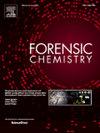Exploiting a gold leaf-based voltammetric sensor for the estimation of firing distance
IF 2.2
3区 医学
Q2 CHEMISTRY, ANALYTICAL
引用次数: 0
Abstract
In this study, we present a novel electrochemical approach for firing distance estimation using a gold leaf-based sensor integrated with screen-printed electrodes. This is the first report of employing a gold leaf-based sensor for the voltammetric estimation of firing distance by detecting Pb in gunshot residue (GSR) on fabric targets. The sensor consists of a gold leaf sheet as the working electrode, with carbon and silver/silver chloride screen-printed electrodes serving as the counter and reference electrodes, respectively. Pb(II), a key component of GSR, was extracted from 15 mm fabric discs using manual shaking in nitric acid for 3 min. The extracted solution was analyzed by anodic stripping voltammetry (ASV) with a portable electrochemical system. The Pb(II) signal was then correlated with the firing distance to construct an analytical curve for estimation of shooting distance in the range of 5–60 cm. The resulting mathematical model enables accurate distance estimation. This cost-effective, reagent-free, and field-deployable electrochemical sensor offers a rapid and accessible alternative for forensic firearm investigations.

利用金箔伏安传感器估算射击距离
在这项研究中,我们提出了一种新的电化学方法来估计发射距离,该方法使用基于金箔的传感器集成了丝网印刷电极。本文首次报道了利用金箔传感器通过检测织物目标上的枪弹残余物(GSR)中的铅来伏安估计射击距离。该传感器由金箔片作为工作电极,碳和银/氯化银丝网印刷电极分别作为计数电极和参比电极。从15 mm的织物圆盘中提取GSR的关键成分Pb(II),在硝酸中手动振荡3 min,提取液采用便携式电化学系统阳极溶出伏安法(ASV)进行分析。将Pb(II)信号与发射距离进行关联,构建了估算5 ~ 60 cm范围内发射距离的解析曲线。由此产生的数学模型可以进行精确的距离估计。这种低成本、无试剂、可现场部署的电化学传感器为法医枪支调查提供了一种快速、方便的替代方案。
本文章由计算机程序翻译,如有差异,请以英文原文为准。
求助全文
约1分钟内获得全文
求助全文
来源期刊

Forensic Chemistry
CHEMISTRY, ANALYTICAL-
CiteScore
5.70
自引率
14.80%
发文量
65
审稿时长
46 days
期刊介绍:
Forensic Chemistry publishes high quality manuscripts focusing on the theory, research and application of any chemical science to forensic analysis. The scope of the journal includes fundamental advancements that result in a better understanding of the evidentiary significance derived from the physical and chemical analysis of materials. The scope of Forensic Chemistry will also include the application and or development of any molecular and atomic spectrochemical technique, electrochemical techniques, sensors, surface characterization techniques, mass spectrometry, nuclear magnetic resonance, chemometrics and statistics, and separation sciences (e.g. chromatography) that provide insight into the forensic analysis of materials. Evidential topics of interest to the journal include, but are not limited to, fingerprint analysis, drug analysis, ignitable liquid residue analysis, explosives detection and analysis, the characterization and comparison of trace evidence (glass, fibers, paints and polymers, tapes, soils and other materials), ink and paper analysis, gunshot residue analysis, synthetic pathways for drugs, toxicology and the analysis and chemistry associated with the components of fingermarks. The journal is particularly interested in receiving manuscripts that report advances in the forensic interpretation of chemical evidence. Technology Readiness Level: When submitting an article to Forensic Chemistry, all authors will be asked to self-assign a Technology Readiness Level (TRL) to their article. The purpose of the TRL system is to help readers understand the level of maturity of an idea or method, to help track the evolution of readiness of a given technique or method, and to help filter published articles by the expected ease of implementation in an operation setting within a crime lab.
 求助内容:
求助内容: 应助结果提醒方式:
应助结果提醒方式:


